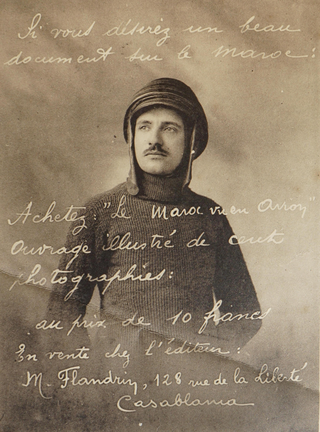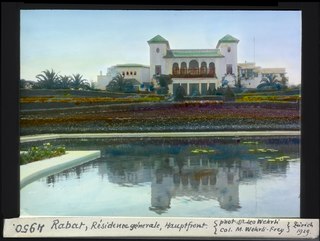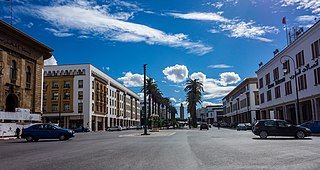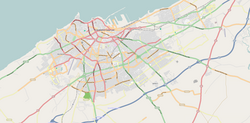
Casablanca is the largest city in Morocco and the country's economic and business centre. Located on the Atlantic coast of the Chaouia plain in the central-western part of Morocco, the city has a population of about 3.71 million in the urban area, and over 4.27 million in Greater Casablanca, making it the most populous city in the Maghreb region, and the eighth-largest in the Arab world.

Louis Hubert Gonzalve Lyautey was a French Army general and colonial administrator.

The French protectorate in Morocco, also known as French Morocco, was the period of French colonial rule in Morocco that lasted from 1912 to 1956. The protectorate was officially established 30 March 1912, when Sultan Abd al-Hafid signed the Treaty of Fez, though the French military occupation of Morocco had begun with the invasion of Oujda and the bombardment of Casablanca in 1907.

A medina is a historical district in a number of North African cities, often corresponding to an old walled city. The term comes from the Arabic word simply meaning "city" or "town".

The history of the city of Casablanca in Morocco has been one of many political and cultural changes. At different times it has been governed by Berber, Roman, Arab, Portuguese, Spanish, French, British, and Moroccan regimes. It has had an important position in the region as a port city, making it valuable to a series of conquerors during its early history.

Bordels Mobiles de Campagne or Bordel Militaire de Campagne were mobile brothels used during World War I, World War II and the First Indochina War to supply prostitution services to French soldiers fighting in areas where brothels were unusual, such as at the front line or in isolated garrisons. The BMCs were significant drivers towards the creation of prostitution regulations within the French army.
Prostitution in Tunisia is regulated and confined to two small areas, one in Sfax and the other, Sidi Abdallah Guech in Tunis. Outside these two areas prostitution is illegal.

Albert Laprade was a French architect, perhaps best known for the Palais de la Porte Dorée. During a long career he undertook many urban renewal projects as well as major industrial and commercial works. A skilled artist, he published a series of sketch books of architecture in France and other Mediterranean countries.

Sidi Abdallah Guech street, officially known as "Impasse Sidi Abdallah Gueche", is the legal red light district in Tunis. It is located in the medina and consists of three narrow winding alleys. There are rooms on both sides of the alleys where girls try to attract clients. Only men are allowed in the alleys.
Although prostitution in Morocco has been illegal since the 1970s it is widespread. In 2015 the Moroccan Health Ministry estimated there were 50,000 prostitutes in Morocco, the majority in the Marrakech area. Prostitutes tend to be Moroccan women from lower socioeconomic backgrounds as well as migrants from sub-Saharan Africa, many of whom are victims of human trafficking UNAIDS estimated the figure at 75,000 in 2016.
Prostitution in Overseas France varies from area to area with regard to extent, law enforcement and legality.

The Bombardment of Casablanca was a French naval attack taking place from August 5 to 7 in 1907 that destroyed the Moroccan city of Casablanca. France used mainly artillery fire from armored cruisers to bomb the city and targets in the surrounding area, which caused an estimated 1,500 to 7,000 Moroccan deaths. The bombardment of Casablanca opened a western front to the French conquest of Morocco after Hubert Lyautey's occupation of Oujda in the east earlier that year.

United Nations Square is a public square in the center of Casablanca, Morocco. It has been central in the history of Casablanca.

The Arab League Park is an urban park in Casablanca, Morocco. It is located in the center of the city, west of Hassan II Boulevard, east of Roudani Boulevard and Algiers Street, and south east of the Church of the Sacred Heart. The park covers 30 acres of land, and is bisected by Moulay Youssef Boulevard. As of 2019, it remains officially closed to the public after renovations started March 2016, though it was expected to open September 2018.

Marcelin Flandrin (1889–1957) was a French military photographer.

Mohammed V Square is a public square of historical and symbolic significance located in central Casablanca, Morocco. It was established in 1916 at the beginning of the French protectorate in Morocco under Resident-general Hubert Lyautey, on a design by architects Henri Prost and Joseph Marrast.
The Wilaya Building is the building that houses the administration of Grand Casablanca. It was designed by Marius Boyer and built from 1928-1937 during the French Protectorate in Morocco. The building is located at Muhammad V Square in central Casablanca, Morocco, and it remains an emblematic building of the city's architecture.

The architecture of Casablanca is diverse and historically significant. Casablanca, Morocco's economic capital, has a rich urban history and is home to many notable buildings in a variety of styles. Throughout the 20th century, architecture and urban development in Casablanca evolved in a way that was simultaneously specific to the city's contexts, and consonant with international ideas.

The French Protectorate Residence also known as Residence-general or Residence of Lyautey, is a historic building in Rabat, Morocco. It was the seat of the Resident-general in the French protectorate in Morocco from its completion in 1924 to the end of the protectorate in 1956.

Avenue Mohammed V, sometimes referred to by its old name Avenue Dar al-Makhzen, is a major thoroughfare in downtown Rabat, Morocco. Its main section was created under the French Protectorate in Morocco and mostly developed between 1915 and 1932, when it was also known as Cours Lyautey. At the southern end of that section is the As-Sunna Mosque, whose history dates back to the 18th century like that of the nearby royal palace or Dar el-Makhzen.




















